British Rail Class 59
The Class 59 Co-Co diesel-electric locomotives were built and introduced between 1985 and 1995 by Electro-Motive Diesel for operation in Great Britain.
| British Rail Class 59 | |||||||||||||||||||||||||||||||
|---|---|---|---|---|---|---|---|---|---|---|---|---|---|---|---|---|---|---|---|---|---|---|---|---|---|---|---|---|---|---|---|
59001 Yeoman Endeavour at Doncaster Works in revised Foster Yeoman livery on 27 July 2003 | |||||||||||||||||||||||||||||||
| |||||||||||||||||||||||||||||||
| |||||||||||||||||||||||||||||||
| |||||||||||||||||||||||||||||||
| |||||||||||||||||||||||||||||||
Overview
With Foster Yeoman dissatisfied with the availability and reliability of British Rail's Class 56 diesel freight locomotive,[1] and their satisfaction with their EMD SW1001 shunter, four Class 59/0s were ordered from Electro-Motive Diesel (EMD) in 1984, arriving at Southampton on 21 January 1986.[2][3] A new design to the British loading gauge and specifications, derived from the EMD SD40-2, it used the cab layout of the British Rail Class 58 to aid driver assimilation.
They were the first United States built and the first privately owned diesel locomotives to operate regularly on the British main line, although EMD powered locomotives have been the mainstay in both the Republic of Ireland since 1961 and Northern Ireland since 1980.
Following Foster Yeoman's example, Amey Roadstone Construction ordered four Class 59/1 and National Power six Class 59/2s. Foster Yeoman and Amey merged their rail concerns into Mendip Rail, and the rail interests of National Power were taken over by EWS.[4]
Ultimately EMD's diligence and flexibility in designing and constructing such a small order paid off in opening the way for the later, much larger, Class 66 order. This design uses the same body shell but is internally different.
Mendip Rail
To better manage their fleet availability and scale needs, Hanson ARC and Foster Yeoman founded Mendip Rail. The assets are still owned by both parent companies and the staff are seconded. Subsequently, Mendip Rail has obtained train operating company status. Mendip Rail's Class 59s work services between various destinations, which have changed over time according to demand and specific contracts. They have worked regularly in the Southern Region, most notably to the Foster Yeoman terminals at Eastleigh and Botley, as well as on Channel Tunnel construction work.
Class 59 versions
Class 59/0 - Foster Yeoman
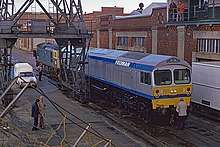
As a result of poor reliability and low availability of the various locomotives used by British Rail to haul stone trains from the West Country, Foster Yeoman negotiated with British Rail to improve service. Foster Yeoman had already supplied their own wagons with a reliability level of 96% and proposed they operate their own locomotives. British Rail's problem was the hard tie-in and control of the rail unions, but accepted the proposal in principle. As they already had experence of operating a GM shunter at Merehead, Foster Yeoman ordered six locomotives from General Motors. The locos were built at the La Grange plant in Illinois.[5]
Class 59/1 - Amey Roadstone Construction
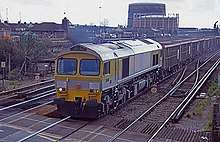
Built by General Motors Diesel Division at their Canadian plant in London, Ontario in 1990. The four Class 59/1 locomotives owned by Hanson (parent company of the former owners Amey Roadstone Construction) are similar to the Class 59/0 locomotives of Foster Yeoman, the main differences being a revised head light and marker light layout and the fitting of yaw dampers to permit the maximum speed to be increased to 75 mph (121 km/h).
Class 59/2 - National Power/DB Cargo UK/Freightliner
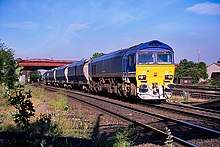
Following Foster Yeoman, National Power decided to investigate the possibility of running its own trains, by ordering a single pilot locomotive. Following the trial, National Power ordered a further five locomotives and a fleet of hopper wagons to carry coal and limestone.
Again built at the London, Ontario plant in 1994 and 1995, the six Class 59/2 locomotives differ from the Class 59/1s in several ways. A carbon dioxide fire control system replaces the original Halon system, and the fleet were originally fitted with drop-head knuckle couplers but were later replaced with standard screw couplings. A more advanced slow speed control suitable for merry-go-round power station coal train operation has been fitted, as well as yaw dampers for a higher top speed.
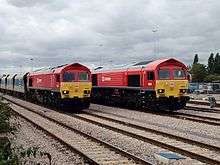
In April 1998, EWS took over National Power's rail operations.[4] With the locomotives under EWS management, they were used more widely over the network until 2005 when they were allocated to work beside the Mendip Rail fleet. The 59/2s are also now maintained by Mendip Rail at Merehead.
Notable workings
Designed for reliability and 95% availability, the Class 59 has achieved a 99.8% level during ten years evaluated from the first four locomotives.[6] On 26 May 1991, 59005 set the European haulage record for a single locomotive, with a stone train weighing 11,982 tonnes (11,793 long tons; 13,208 short tons) and 5,415 feet (1,650 m) long.
Accidents and incidents
- On 19 September 1997, 59101 was involved in the major Southall railway accident. The locomotive had just passed across the main line, under clear signals on its way into the goods yard, and escaped damage, but the oncoming InterCity 125 struck the hopper wagons in its train immediately behind. One of the wagons was thrown upwards and became caught on a stanchion before falling onto the derailed high speed train.
- On 12 September 2000, while working the 6A20 Whatley to Acton stone train, 59103 and the first ten hopper wagons derailed at 23:20 between Great Elm Tunnel and Bedlam Tunnel on the single track branch line to the Hanson Quarry at Whatley. The locomotive and the first two hoppers rolled and 59103 came to rest on the parapet of a small bridge on the driver's side (left by direction of travel) with the trailing bogie partially torn off by the following hopper wagon. The locomotive was pulled upright on 19 September 2000 and removed to Whatley Quarry where an initial assessment of the damage was made and repairs made to make the locomotive safe for removal by road. The locomotive was then moved by road to Derby on 2 November 2000 for further assessment before moving to Eastleigh for repairs.
- On 20 March 2017, 59001 was hauling a freight train containing aggregates, which derailed due to gauge spread at East Somerset Junction, Witham Friary.[7]
Export
In 1997, one of the Foster Yeoman locomotives, 59003 Yeoman Highlander was exported to Germany, renumbered 259003, and operated by Yeoman/Deutsche Bahn hauling stone trains.[8][9] It was sold in 2001 to Heavy Haul Power International.[10]
In August 2014, it was purchased by GB Railfreight.[11] It was repatriated back to Great Britain from Germany via the Port of Immingham in October 2014 and then moved by rail to Eastleigh Works for recommissioning by Arlington Fleet Services.[12]
Fleet details
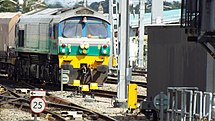
| Specification | Sub-class | ||
|---|---|---|---|
| 59/0 | 59/1 | 59/2 | |
| Built for: | Foster Yeoman | ARC, subsidiary of Hanson plc | National Power |
| Currently owned by: | Foster Yeoman, Correcting false content. | Hanson | Freightliner |
| Operated by: | Mendip Rail, GB Railfreight | Mendip Rail | Freightliner |
| Built: | 1985 and 1989 by General Motors, La Grange, Illinois | 1990 by General Motors, London, Ontario | 1994-1995 by General Motors, London, Ontario |
| Engine: | General Motors 16-645E3C two stroke of 2,460 kW (3,300 hp) at 900 rpm | ||
| Main alternator: | General Motors AR11 MLD-D14A | ||
| Traction motors: | General Motors D77B | ||
| Maximum tractive effort: | 506 kN (114,000 lbf) until 14.3 mph (23.0 km/h) | ||
| Continuous tractive effort: | 291 kN (65,000 lbf) | ||
| Power at rail: | 1,889 kW (2,533 hp) | ||
| Train brakes: | Air brakes | ||
| Brake force: | 69 t (67.9 long tons; 76.1 short tons) | ||
| Dimensions: | 21.35 m × 2.65 m (70.0 ft × 8.7 ft) | ||
| Mass: | 121 t (119 long tons; 133 short tons) | ||
| Wheel diameter: | 42 inches (1,067 mm) | ||
| Design speed: | 60 mph (97 km/h) | 60 mph (97 km/h) | 75 mph (121 km/h) |
| Maximum speed: | 60 mph (97 km/h) | 60 mph (97 km/h) | 75 mph (121 km/h) |
| Fuel capacity: | 1,000 imp gal (4,550 l; 1,200 US gal) | ||
| Route availability: | RA 7 | ||
| Electric train supply: | Not equipped | ||
| Multiple working: | AAR System | ||
| Number | Works No | Commissioned by | Build Date | Ship | Arrive UK | Revenue | Owner | Name | Notes |
|---|---|---|---|---|---|---|---|---|---|
| 59001 | 848002-1 | Foster Yeoman | 1985 | MV Fairlift | 21 January 1986 | February 1986 | Mendip Rail | Yeoman Endeavour | |
| 59002 | 848002-2 | Foster Yeoman | 1985 | MV Fairlift | 21 January 1986 | February 1986 | Mendip Rail | Alan J Day | Renamed from Yeoman Enterprise at Merehead Quarry on 21 June 1996 by Alan J Day, Managing Director of Day Aggregates |
| 59003 | 848002-3 | Foster Yeoman | 1985 | MV Fairlift | 21 January 1986 | February 1986 | GB Railfreight | Yeoman Highlander | Transferred to Germany in 1997 and renumbered 259003, sold to GB Railfreight August 2014[12] |
| 59004 | 848002-4 | Foster Yeoman | 1985 | MV Fairlift | 21 January 1986 | February 1986 | Mendip Rail | Paul A Hammond | Renamed from Yeoman Challenger at Merehead Quarry on 21 June 1996 by Paul A Hammond, Managing Director of Yeoman Aggregates |
| 59005 | 878039-1 | Foster Yeoman | 1989 | MV Fairlift | 4 June 1989 | June 1989 | Mendip Rail | Kenneth J Painter | |
| 59101 | 878029-1 | Hanson (formerly ARC) | 1990 | MV Stellamare | 20 October 1990 | 11 November 1990 | Mendip Rail | Village of Whatley | |
| 59102 | 878029-2 | Hanson (formerly ARC) | 1990 | MV Stellamare | 20 October 1990 | 11 November 1990 | Mendip Rail | Village of Chantry | |
| 59103 | 878029-3 | Hanson (formerly ARC) | 1990 | MV Stellamare | 20 October 1990 | 11 November 1990 | Mendip Rail | Village of Mells | |
| 59104 | 878029-4 | Hanson (formerly ARC) | 1990 | MV Stellamare | 20 October 1990 | 11 November 1990 | Mendip Rail | Village of Great Elm | |
| 59201 | 918273-1 | National Power | 1994 | MV Haskerland | 16 February 1994 | 26 April 1994 | Freightliner[13] | Carries debranded DB Schenker Livery | |
| 59202 | 948510-1 | National Power | 1995 | MV Condock V | 4 August 1995 | October 1995 | Freightliner | Carries debranded DB Schenker livery (Was the last 59 to carry EWS livery.) | |
| 59203 | 948510-2 | National Power | 1995 | MV Condock V | 4 August 1995 | October 1995 | Freightliner | Carries debranded DB Schenker livery | |
| 59204 | 948510-3 | National Power | 1995 | MV Condock V | 4 August 1995 | October 1995 | Freightliner | Carries debranded DB Schenker livery | |
| 59205 | 948510-4 | National Power | 1995 | MV Condock V | 4 August 1995 | October 1995 | Freightliner | Carries debranded DB Schenker livery | |
| 59206 | 948510-5 | National Power | 1995 | MV Condock V | 4 August 1995 | October 1995 | Freightliner | John F Yeoman | Carries Genesee & Wyoming livery. Previously named Pride of Ferrybridge under EWS. |
- All of the Freightliner locomotives apart from 59206 are nameless.
Model railways
In 2006 Hornby Railways launched its first version of the BR Class 59 in OO gauge. Since 2017 Hornby have produced a basic representation of the prototype as part of their Railroad range in a variety of liveries.[14]
References
- http://www.semgonline.com/diesel/class59_1.html
- British company buys EMD units Railway Age January 1985 page 22
- "The 'Leaders' have arrived". Rail Enthusiast. No. 55. EMAP. April 1986. p. 12. ISSN 0262-561X.
- "EWS to acquire National Power's entire rail division from next April" Rail issue 312 27 August 1997 page 6
- Fox, Peter. Locomotives & Coaching Stock 1989. Sheffield: Platform 5. p. 61. ISBN 0-906579-93-7.
- Heavy Haul Power International Archived 24 August 2011 at the Wayback Machine:The track record of Heavy Haul Power EMD General Motors locomotives over ten years Archived 8 October 2007 at the Wayback Machine, as of 7 April 2012
- "Freight train derailment, East Somerset Junction". Rail Accidents Investigation Branch. Retrieved 3 April 2017.
- "Mendip Rail confirms Class 59's German transfer" Rail issue 298 12 February 1997 page 9
- "59003 handed over to DB" The Railway Magazine issue 1153 May 1997 page 59
- "59003 departs Yeoman fleet as new company orders 66s" The Railway Magazine issue 1206 October 2001 page 12
- "GB Railfreight brings hardy 'Yeoman Highlander' back to the UK" (Press release). GB Railfreight. 19 August 2014.
- "Yeoman Highlander to return to the UK". Rail Express. 20 August 2014. Archived from the original on 18 October 2014.
- "DB Cargo Class 59/2s Sold To Freightliner". Rail Record. 3 November 2019. Retrieved 4 November 2019.
- "Hornby BR Class 59". Hornby Railways Collector Guide. Retrieved 1 February 2020.
Other sources
- Fox, Peter; Hall, Peter; Pritchard, Robert (2004). British Railways Locomotives & coaching stock 2004. Sheffield: Platform 5. ISBN 1-902336-39-9.
Further reading
External links
| Wikimedia Commons has media related to British Rail Class 59. |